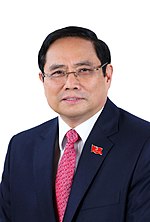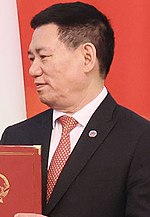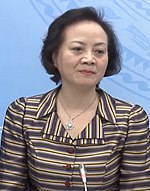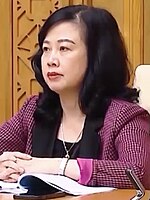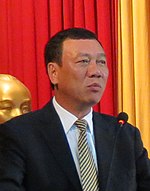|
Government of Vietnam
The Government of the Socialist Republic of Vietnam (Vietnamese: Chính phủ nước Cộng hòa xã hội chủ nghĩa Việt Nam; less formally the Vietnamese Government or the Government of Vietnam, Vietnamese: Chính phủ Việt Nam) is the cabinet and the central executive body of the state administration of Vietnam. The members of the Government are appointed by the President of Vietnam on the advice of the Prime Minister of Vietnam and approved by the National Assembly. The Government is led by the Communist Party of Vietnam (CPV), which is headed by the CPV general secretary, often seen as the highest political post in Vietnam. The current government is the Government of Phạm Minh Chính (also known as the Government of the 15th National Assembly), which was established in accordance with the 2013 Constitution of the Socialist Republic of Vietnam. Throughout history, each state administration of Vietnam had developed its own government cabinet. NamesAfter the establishment of the Democratic Republic of Vietnam on 2 September 1945, based on the 1946 Constitution, the executive branch was called the Government (Chính phủ). The Government was headed by the president, which was the second highest position in Vietnam. Under the president was the Cabinet, which was headed by the prime minister (Thủ tướng). From 1959 to 1980, based on the 1959 Constitution, the executive branch was named as the Council of Government (Hội đồng Chính phủ). The Council of Government was headed by the prime minister. From 1980 to 1992, based on the 1980 Constitution, the executive branch was called the Council of Ministers (Hội đồng Bộ trưởng). The Council of Ministers was headed by the chairman (equivalent to the prime minister). From 1992 onwards, based on the 1992 Constitution the executive branch was renamed as the Government (Chính phủ). The Government is headed by the prime minister. TermBased on The 2013 Constitution, the term of the Government follows the term of the National Assembly. At the expiration of the term of the National Assembly, the Government shall remain in office until a new Government is elected by the succeeding National Assembly.[1][2] HistoryCouncil of Ministers (1980–1992)The Vietnamese Council of Ministers (Hội đồng Bộ trưởng) was entrusted by the 1980 Constitution with managing and implementing the governmental activities of the state.[3] It is described in that document as "the Government of the Socialist Republic of Vietnam, the highest executive state body of the highest body of state authority." It is accountable to the National Assembly of Vietnam, and, more directly, to the Vietnamese Council of State when the National Assembly is not in session. Its duties include submitting draft laws, decrees, and other bills to the National Assembly and the Council of State; drafting state plans and budgets and implementing them following the National Assembly's approval; managing the development of the national economy; organising national defence activities and assuring the preparedness of the armed forces; and organising and managing the state's foreign relations. Its membership includes a chairman, vice-chairman, cabinet ministers, and the heads of state committees, whose terms of office coincide with that of the National Assembly. The Council of Ministers includes its own standing committee, which serves to co-ordinate and mobilise the council's activities. In 1986 the standing committee was expanded from ten to thirteen members. Each ministry is headed by a minister, who is assisted by two to twelve deputy ministers. The number and functions of the ministries are not prescribed in the Constitution, but in 1987 there were twenty-three ministries and a number of other specialised commissions and departments. In an apparent response to the call by the Sixth National Party Congress in 1986 for a streamlined bureaucracy, several ministries were merged. The former ministries of agriculture, food, and food industry were joined in a newly created Ministry of Agriculture and Food Industry. The ministries of power and mines were merged to form the Ministry of Energy, and a newly created Ministry of Labour, War Invalids, and Social Welfare consolidated the duties of three former ministries. The addition of two new ministerial bodies also resulted from the 6th National Party Congress: a Ministry of Information to replace the Vietnam Radio and Television Commission, and a mission for Economic Relations with Foreign Countries to act as a co-ordinating body for foreign aid. Government (since 1992)Since 1992 the executive branch of the Socialist Republic of Vietnam is officially named the Government (Chính phủ). The current Government of Vietnam consists of 18 ministries, 4 ministry-level agencies and 8 other government-dependent agencies. CompositionThe Government is headed by a prime minister (Thủ tướng) and four deputy prime ministers (Phó Thủ tướng). There are 18 ministries (Bộ); each is headed by a minister (Bộ trưởng):[4]
Four ministry-level agencies:[5]
Eight other government-dependent agencies:[6]
In addition, the Government of Vietnam also establishes many national committees (Ủy ban Quốc gia) when needed. The national committees are not separate political entities or ministries; instead they are composed of deputy prime ministers, ministers and deputy ministers in appropriate fields. The national committees act as advisor bodies to the prime minister on social and economic issues, and coordinate actions between many ministries and agencies. Therefore, the national committees do not have any executive powers. Currently there are nine national committees;[7] each is headed by a chairman (Chủ tịch):
Current governmentIncumbent Prime Minister Phạm Minh Chính, who had replaced Nguyễn Xuân Phúc as prime minister since 5 April 2021, was re-elected on 26 July 2021 following a 484–0 vote by the National Assembly.[8] After taking the oath of office on the same day, Chính nominated 26 people to serve in his Cabinet, including 4 deputy prime ministers (1 fewer than the previous term), 18 ministers, and 4 heads of ministerial-level agencies. The lineup was approved by the National Assembly on 28 July 2021. Cabinet members are expected to serve a five-year renewable term ending before the 2026 election.[9][10] The heads of other government-dependent agencies are appointed by the Prime Minister without approval by the National Assembly. Usually there is no term limit on the leaders of those agencies. The current heads of the government-dependent agencies are:
References
External links |
||||||||||||||||||||||||||||||||||||||||||||||||||||||||||||||||||||||||



